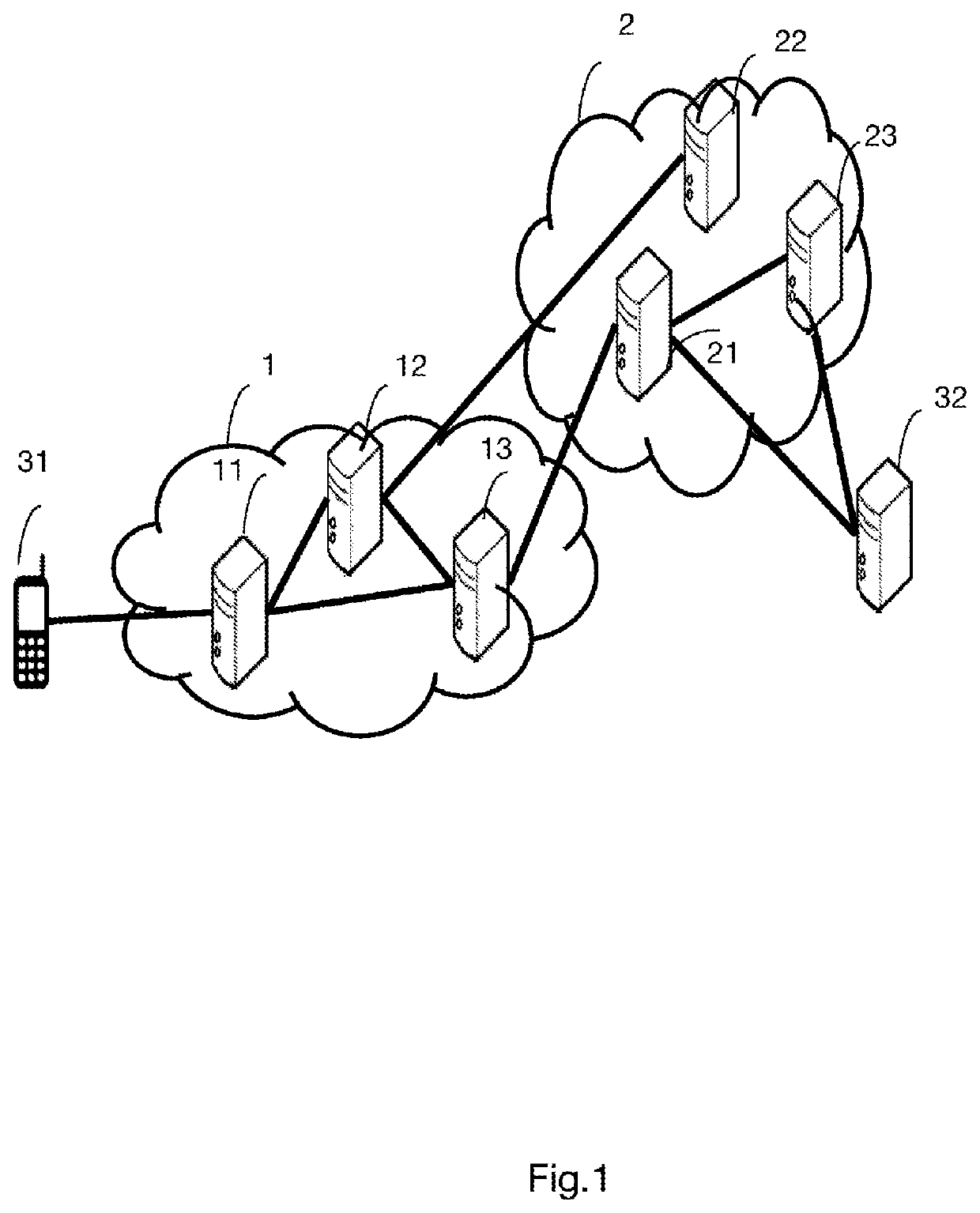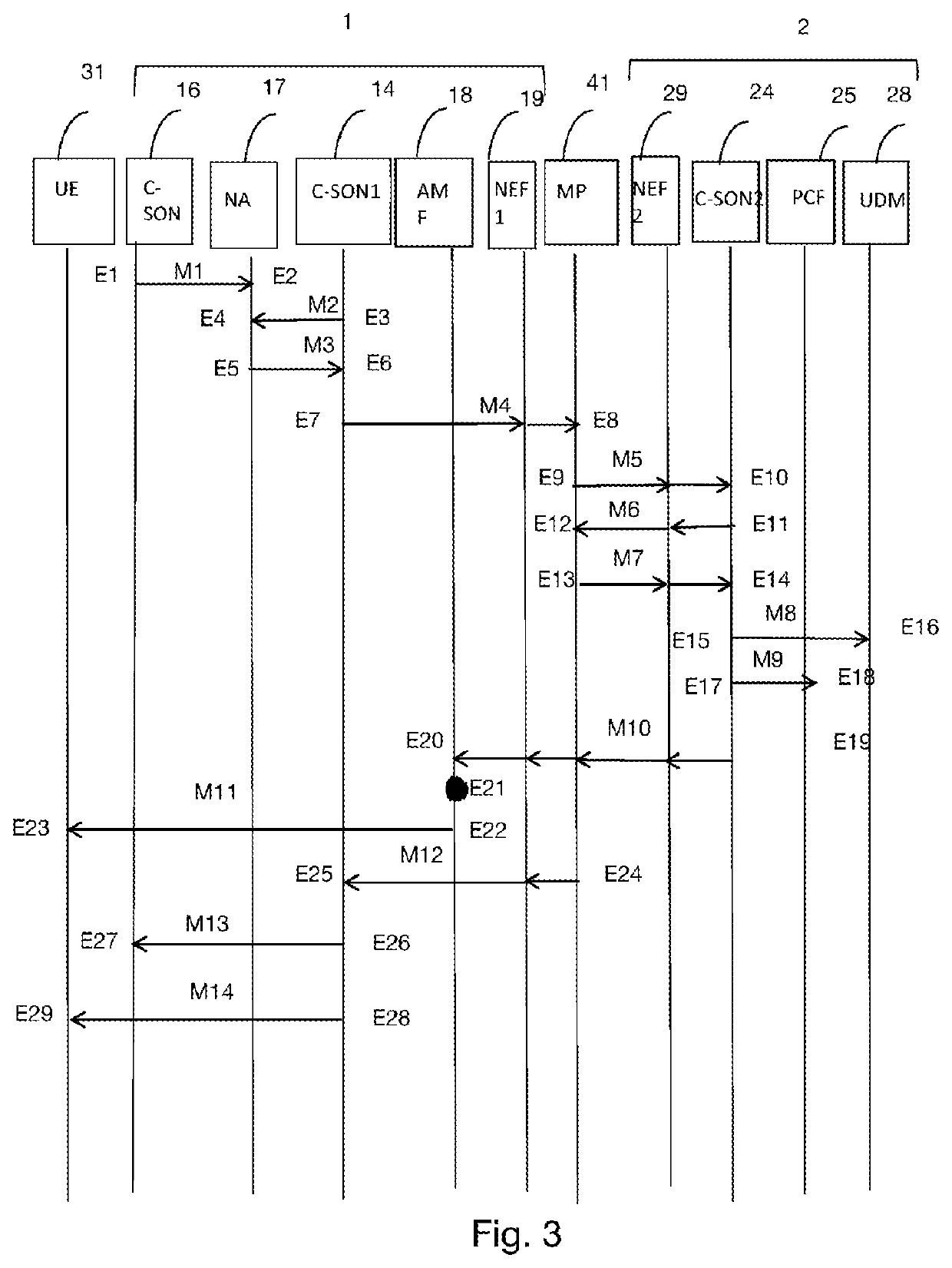Method for dynamically configuring entities of a communications network for routing data from a visitor terminal
a dynamic configuration and data technology, applied in the field of access networks, can solve the problems of relatively difficult implementation of network sharing options, limited access to the second network, and high cost of operators to deploy their specific infrastructures, and achieve the effect of limiting the possibility of accessing the second network
- Summary
- Abstract
- Description
- Claims
- Application Information
AI Technical Summary
Benefits of technology
Problems solved by technology
Method used
Image
Examples
first embodiment
[0060]FIG. 2 shows an architecture of a roaming service between two communications network operators in which the configuration method is implemented, according to a
[0061]The following changes from FIG. 1 are taken into consideration in this FIG. 2.
[0062]According to one example, the user of the terminal 31 may purchase a roaming service via credits (also called tokens). The credits are available for example in the digital wallet of the user of the terminal 31, which is attached to the account of the user subscribed to the operator of the network 2 (Home). The terminal may use these credits on visited networks. It should be noted that the credits could also be used by the user to connect to the network 2 if the subscription to the operator of the network 2 involves providing a number of credits to attach to the network 2.
[0063]This FIG. 2 also differs from FIG. 1 through the addition of new entities. The entity 14 in the network 1 is a management entity of the network 1 whose purpos...
second embodiment
[0070]FIG. 3 shows an overview of the method for configuring a terminal, according to the invention. This embodiment is implemented in a 5G network architecture as defined in document 3GPP TS 23.501 (Version 12 / 2017).
[0071]In step E1, a C-SON (“Centralized Self-Organizing Network”) entity 16, managing the resources of the access networks of the network 1, transmits, to an NA (“Network Analytics”) entity 17, a message M1 comprising information regarding the radio antenna capacities of the access networks of the network 1.
[0072]The purpose of the C-SON entity 16 is to automatically update the configurations of the network equipments in order to balance the load and in particular optimize the use of the various equipments. This message M1 is transmitted periodically. A C-SON1 management entity 14 of the entire network 1, in step E3, transmits a message M2 comprising information regarding the terminals attached to the network 1 as well as the identifiers of these terminals to the NA ent...
third embodiment
[0092]FIG. 4 shows an overview of the method for configuring a terminal, according to the invention. Entities in the figure corresponding to the entities described in FIGS. 1 and 2 are identified by the same numbers in FIG. 4. In this FIG. 4, compared to FIG. 3, the network 1 does not have an NA entity 17.
[0093]Steps E′1 to E′14 are identical to steps E1 to E14 in FIG. 3, with the difference that there is no step E′3 to E′6 in FIG. 4 due to the absence of an NA entity. The entity 16 thus transmits statistics regarding the use of the access networks to the C-SON1 entity 14 in a message M′1, and the entity 14 transmits the information regarding the connected terminals and the availability or the lack of resources in a message M′4 transmitted to the entity 41.
[0094]Steps E′15 to E′18 are identical to steps E15 to E18, with the difference that the PCRF control entity 26 replaces the PCF entity and the HSS entity 22 replaces the UDM entity of FIG. 3, but taking their respective roles and...
PUM
 Login to View More
Login to View More Abstract
Description
Claims
Application Information
 Login to View More
Login to View More - R&D
- Intellectual Property
- Life Sciences
- Materials
- Tech Scout
- Unparalleled Data Quality
- Higher Quality Content
- 60% Fewer Hallucinations
Browse by: Latest US Patents, China's latest patents, Technical Efficacy Thesaurus, Application Domain, Technology Topic, Popular Technical Reports.
© 2025 PatSnap. All rights reserved.Legal|Privacy policy|Modern Slavery Act Transparency Statement|Sitemap|About US| Contact US: help@patsnap.com



